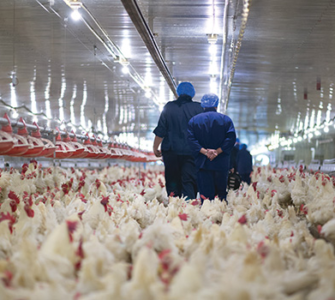What makes a chick tick: Help non-farm audiences understand poultry’s needs
Rather than adopt costly production practices that don’t necessarily benefit the health or welfare of poultry, veterinarians should work to educate non-farm audiences about a bird’s inherent needs and preferences, Phil Stayer, DVM, corporate veterinarian for Sanderson Farms, told Poultry Health Today.
For example, he winces when he hears questions like, “Why do we have solid-wall houses? Why don’t we have windows in the houses? Why don’t we put toys in [the grow-out houses]?”
While he knows their intentions are good, the changes consumers advocate don’t always show an understanding of what makes a chick tick.
To explain a chicken’s needs to non-farm audiences, Stayer frequently applies a psychological theory from the early 1940s known as Maslow’s Pyramid. Maslow was a psychologist who developed a universal hierarchy of needs, often illustrated in pyramid form (Figure 1).
Figure 1. Maslow’s pyramid and the pyramid applied to chickens
The first and most basic need, according to Maslow, is physiological. At the top of the hierarchy is self-actualization — when fulfillment enables a person to be at their very best. Chickens won’t realize “self-actualization” the way people do, Stayer told Poultry Health Today, but they can be content when their basic needs are met.
Because they are prey animals, one of the most basic needs for chickens is protection from predators, Stayer said.
Thermal comfort
Next, chickens need thermal comfort and protection from the environment. Chickens originated in Asia and weren’t designed to be in North America.
“So, we’ve got to make that environment as close to that Asian environment as possible, which is going to be temperature regulation,” he said.
Thermal regulation trumps food and water in importance because if baby chicks aren’t thermally comfortable, they won’t go to food and water, Stayer continued.
Contrary to what some people believe, “I don’t think putting windows in a chicken house is a good thing for a chicken. It might make me feel good — it’s brighter [but] I’m a human…if you turn the lights up on a chicken house… you’re going to find it’s a social stress,” he said.
Flock animals
As for adding toys, Stayer said chickens don’t need self-entertainment. They are social animals and are content when they are with their flock mates.
He related an experience catching chickens that demonstrated birds are less traumatized when catchers held more than one bird per hand instead of one per hand. The birds were comforted by contact with other birds because they are flock animals, he said.
“So, I think we meet those needs of a chicken pretty well in commercial production,” Stayer said.
He stressed the importance of observing and “listening” to chickens to determine what’s best for flocks instead of succumbing to pressure from special-interest groups.
“We, as veterinarians, are involved in the animal well-being of our flocks. So, it’s incumbent upon us to do the best thing for those flocks and not necessarily listen to what the popular media says, or what popular press says. At times I think it’s difficult,” Stayer said.
Editor’s note:
For more insights on Maslow’s Pyramid and its applications in poultry production, click here.
Posted on August 29, 2019

















